00:00
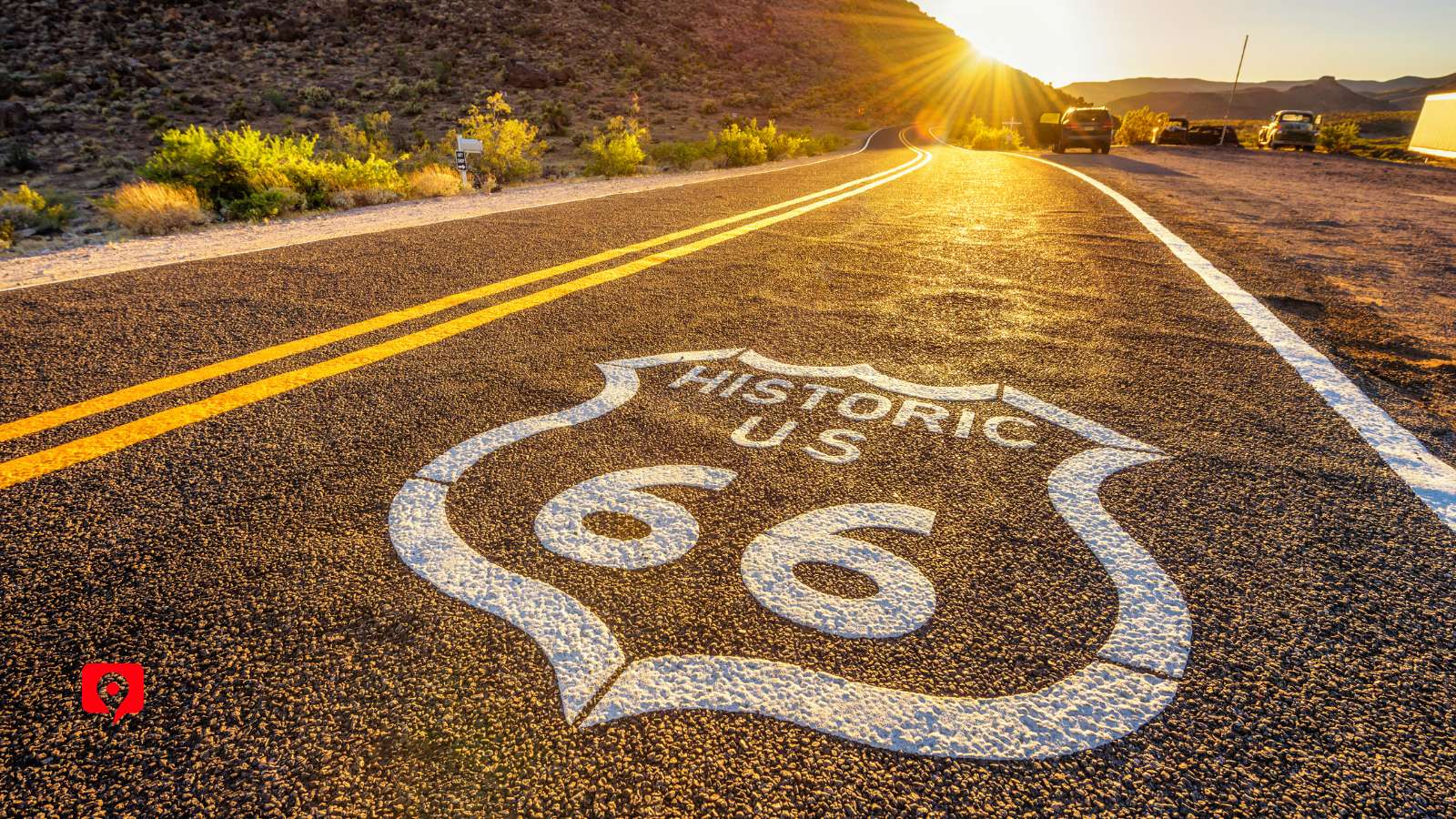
Arizona proudly hosts the longest uninterrupted, drivable stretch of historic Route 66, offering an unparalleled journey back in time. This iconic byway winds through diverse landscapes, from the vibrant hues of the Petrified Forest and Painted Desert to the cool pine forests near Flagstaff.
Experience true Americana in towns like Holbrook, home to the quirky Wigwam Motel, and Winslow, famed for “Standin’ on the Corner.” Seligman, the “Birthplace of Historic Route 66,” and Kingman, rich in Mother Road history, exude vintage charm. Don’t miss Williams, the gateway to the Grand Canyon, or the old mining town of Oatman, where wild burros roam freely. Quirky roadside attractions, classic diners, and glowing neon signs complete this nostalgic adventure through the heart of the Southwest, offering a unique glimpse into a bygone era of American road travel.
Route 66 connects Chicago with Los Angeles, passing through eight states and covering 2,448 miles in total. In Arizona, most road trippers drive down from Las Vegas, following Highway 93 to Kingman. However, those in the know drive from Vegas to Topock instead. This trip takes the same amount of time, and gives you access to one of Route 66’s highlights: the 191 corkscrew turns through the Black Mountain on the Oatman Highway.
If you’re following Route 66 east, you’ll be coming from LA, following I-15 to I-40, with detours along historic stretches of the road.
If you’re following Route 66 west, you’ll take I-40 from Gallup, New Mexico, to the Petrified Forest National Park in Arizona. Our tour begins just outside the national park.
Harry Reid International Airport
The Las Vegas airport (LAS) often has great deals. It’s roughly 105 miles northwest of Kingman; the drive takes roughly an hour and 45 minutes along Highway 93. From Vegas to Topock also takes an hour and 45 minutes , following Highway 95. There are plenty of car rental options at the airport; however, lines can be long and you need to take an additional shuttle to get to the car rental center. Some travelers prefer to take a taxi straight to their hotel and then rent a car.
Los Angeles
Los Angeles International Airport (LAX) is the second-busiest airport in the United States, serving over 150 destinations worldwide. Car rental should be booked ahead; public transportation in LA leaves much to be desired. Los Angeles is about 300 miles west of Topock and the obvious starting point if you’re driving all of Route 66—the starting point is the Santa Monica Pier. Many road trippers spend two to three days on the California section; however, you could drive all the way to the Arizona border in five hours or so.
Phoenix
Sky Harbor Airport is only two hours and change from Flagstaff, although this puts you smack in the middle of Arizona’s section of Route 66. However, if you’re traveling one way (eg to Vegas or LA), this could be a convenient option.
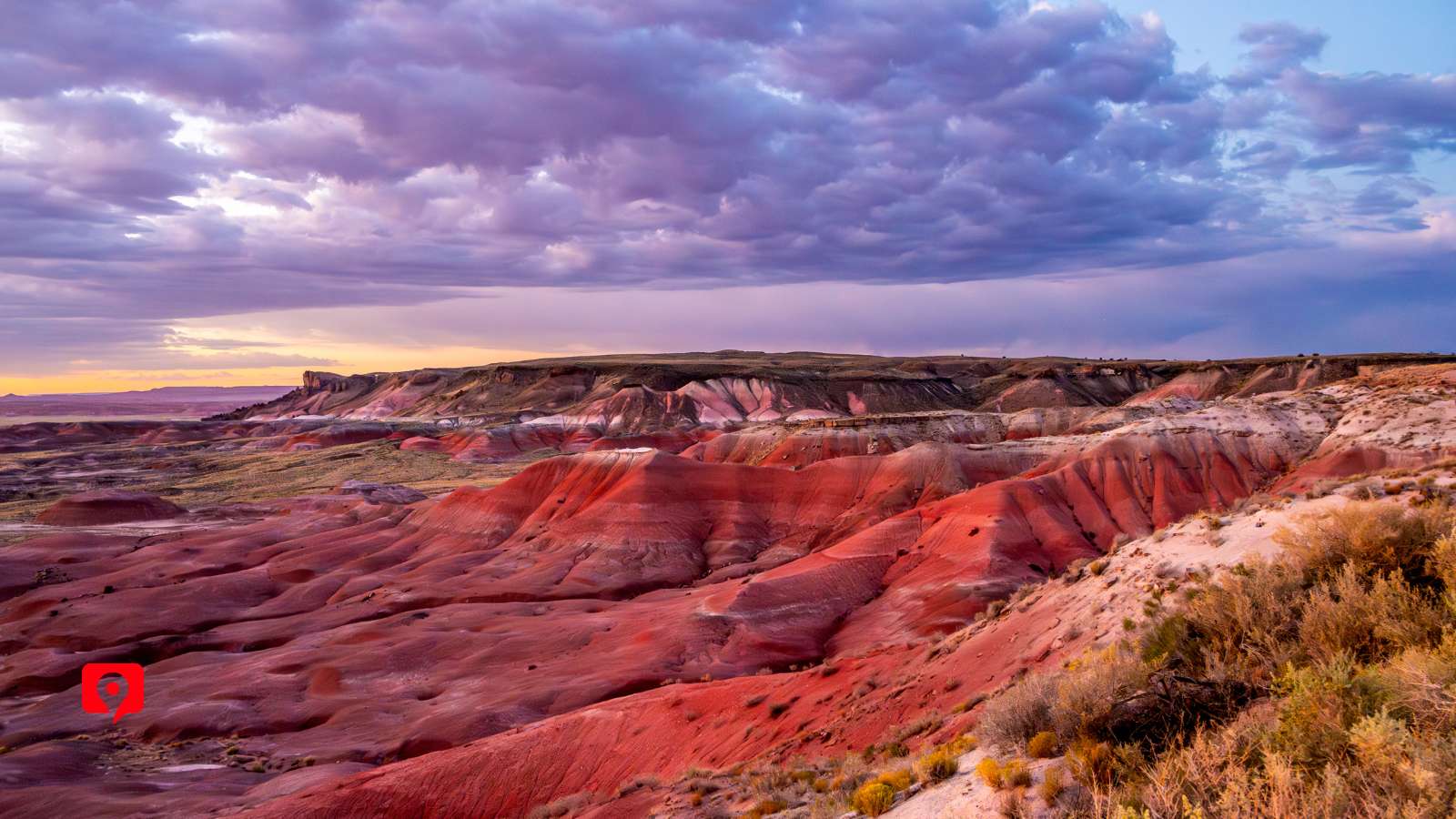
There are no official entrance fees along Route 66, but you will pass several national parks and monuments—several involve slight detours, as they are not exactly on the route. These include: the Lake Mead recreation area (outside Las Vegas), the Grand Canyon, Sunset Crater and Wupatki National Monuments, Walnut Canyon National Monument, and Petrified Forest National Park. Discounted passes are available for veterans, seniors, and families of 4th graders.
If you plan to visit more than one national park, consider purchasing the America the Beautiful National Park Pass. This annual pass provides entrance to all other national parks and federal recreation areas.
The home of all things Route 66 in Arizona, Kingman is an obvious place to lay your head for Mother Road aficionados. It’s got a small town feel with several vintage motels and diners, and makes for a good base if you’re just doing a short trip from Vegas.
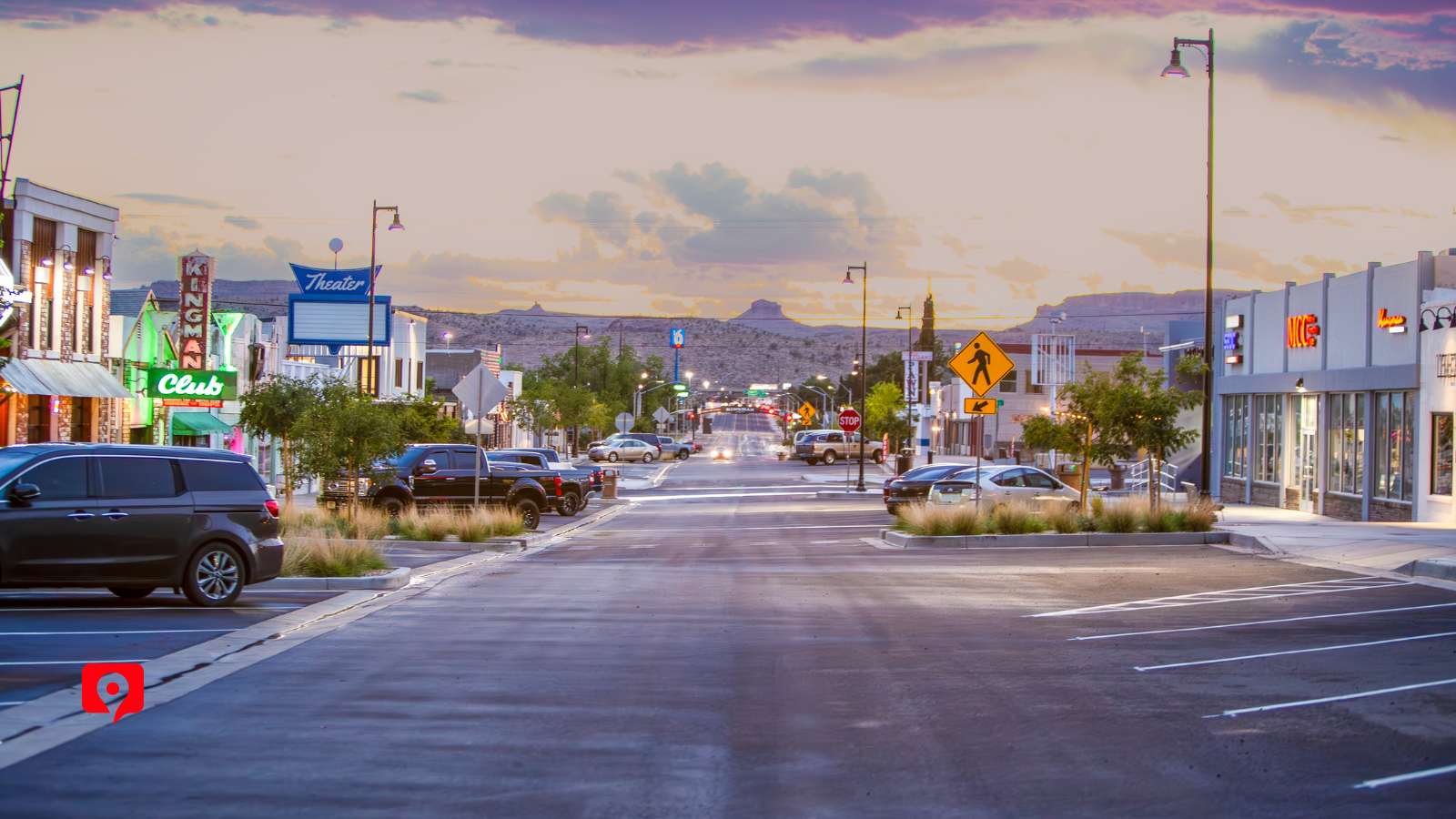
Another historic town with vintage diners and neon-lit motels, Seligman could have come straight out of Cars—or maybe it’s the other way around—but its legendary status is really due to Angel Delgadillo, one-time barber and the guardian angel of the Mother Road. Seligman’s location near the end (or beginning) of the longest continuous stretch of original highway in the country makes it a good place to stop for the night.
The last town along Route 66 to be bypassed by the interstate, Williams is more famous as the gateway to the Grand Canyon. This is where you can pick up the historic Grand Canyon Railway—surely the most unique way to visit the national park. Just an hour from the main entrance at the South Rim, this is also a possible base if you weren’t able to book a room at one of the park’s lodges.
In the running for one of the cutest towns in Arizona, Flag is a bustling place filled with students, outdoorsy types, and adventurers on their way to any number of the fantastic surrounding destinations. This is the highest town on Route 66 (nearly 7,000 feet) and the best place to stay if you want creature comforts like a gourmet dinner or if you need to stock up on supplies. It’s at the halfway point of the tour.
Winslow has a certain blink-and-you-might-miss-it quality, but that’s what makes it all the more attractive. Not only is it refreshingly authentic, but it’s also home to La Posada—a historic Harvey House built in 1930 and the personal favorite of architect Mary Colter. This is the best place to stay on Route 66 if you like historic hotels, and it’s worth planning your trip so that you can spend the night here.
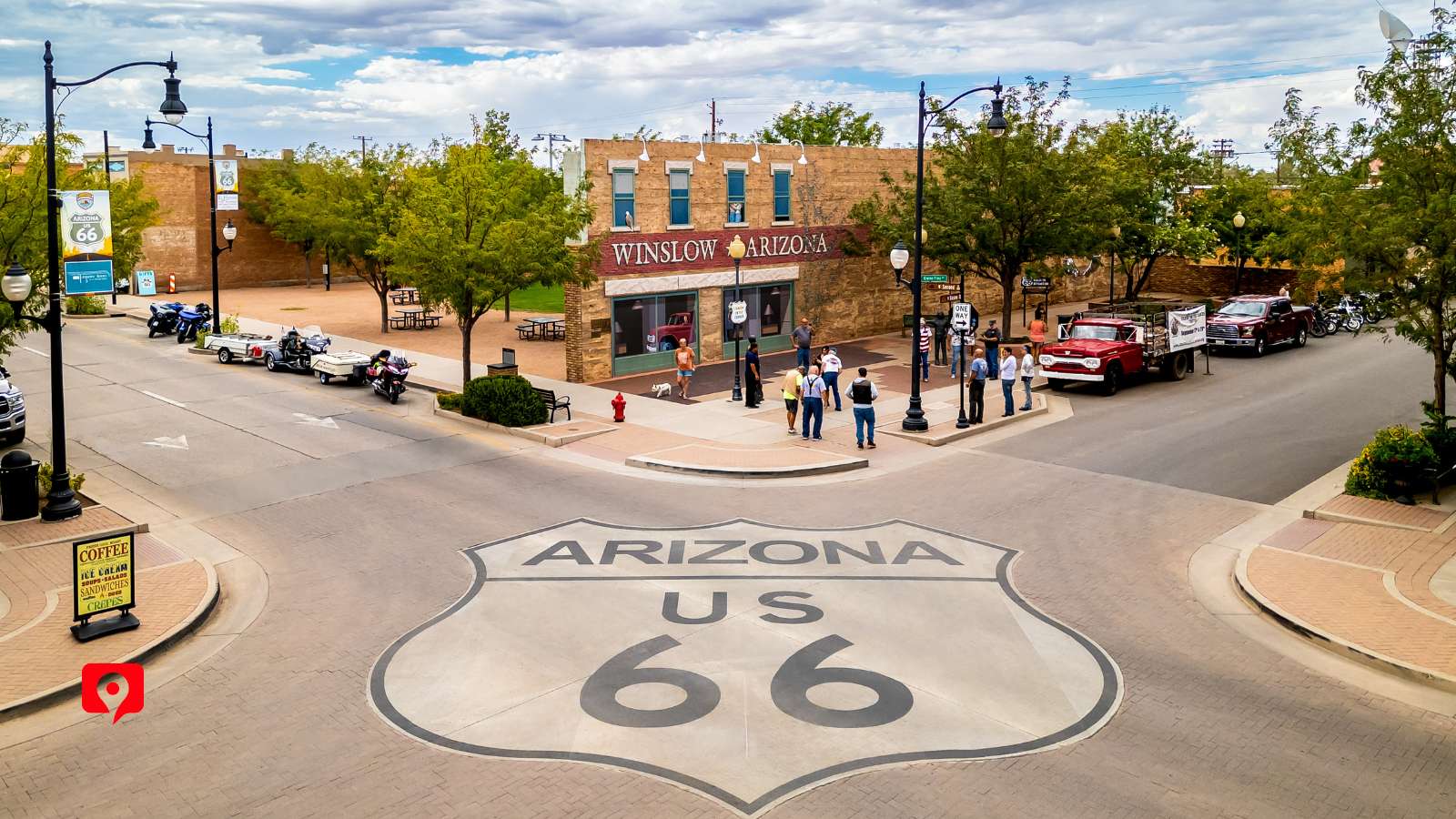
You can drive Route 66 at any time of year, but remember this: Arizona is a geographically diverse state, and the road will climb from just 500 feet above sea level at the California border to 7,335 feet above sea level outside of Flagstaff. Depending on when you go, the weather can range from blazing desert heat to paralyzing blizzards that can shut down the interstate, and torrential downpours that cause flash floods to gorgeous clear nights that are perfect for stargazing. So, in a nutshell, make like a Scout and come prepared. Even in the blistering heat of summer, it’s a good idea to have a warm jacket or fleece, along with rain gear, particularly for the higher elevations near the Grand Canyon. Powerful thunderstorms are common in summer.
Meanwhile, if you go in the winter, make sure you have an appropriate vehicle and all-weather tires for the mountain roads. Snowstorms can be intense and shut down traffic in both directions.

You can definitely drive a small section of Route 66 as one long day trip from Las Vegas. And for some people, one day of driving is the perfect amount. If you want to make a road trip out of it, however, the ideal time frame is three to four days. This gives you enough time to drive the route at your own pace, in addition to taking a detour to see one of the big sights along the way, like the Grand Canyon. One possible itinerary would be to drive from Topock to Williams on day 1. On day 2, visit the Grand Canyon, entering through the south entrance and leaving through east entrance, and then loop down to Flagstaff where you can spend the night and pick up Route 66 again. On day 3, drive the eastern section of Route 66 and spend the night in Winslow, or continue on to the Petrified Forest and New Mexico.

In some places in the middle of the desert, you might find yourself wondering: where did everybody go? At other spots, the narrow, meandering two-lane highway can cause frustrations when there’s a long line of cars stuck behind a giant RV. To avoid the traffic, here are a few tips.

One of the most spectacular sections of Route 66 is in Arizona’s craggy Black Mountains, just before the border with California. This is where the road corkscrews its way up to Sitgreaves Pass, taking in 191 curves, spectacular Mojave Desert views, and plenty of tumbleweeds as you go. You’ll eventually land in dusty Oatman, a one-time mining town where wild burros roam the streets and it gets so hot there’s an annual 4th of July Sidewalk Egg Fry.
Smack in the middle of Route 66’s longest stretch of remaining blacktop, Kingman is a must-stop on any road trip. Drive your vehicle through the Route 66 shield for a can’t-miss photo op, pop in to one of three museums—including the Route 66 Museum—watch the BNSF freight trains rumble by and cool off with a milkshake at an old-timey diner.
East of Kingman is a string of quirky sights like the Hackberry General Store and the country’s deepest underground hotel room (Grand Canyon Caverns). But it’s Seligman that most visitors are aiming to see, for this is where the first Route 66 Association was established in order to keep smaller communities on the map after the interstate passed them by. Sound familiar? Yup, you may have heard Sally Carrera make a similar lament in Cars, which took inspiration from the neon signs and unique personalities along this stretch of road.
Smack in the middle of the world’s largest swathe of ponderosa pine forest is the tiny town of Williams. In October 1984, it was the last town along Route 66 to be bypassed by the interstate. But what it’s best known for is that really, really big hole in the ground about one hour to the north—aka the Grand Canyon. If, like some four million others, you’re driving to the South Rim, chances are high that you’ll pass through Williams.
A historic downtown and great restaurants are what draw folks to Flagstaff—the highest town on Route 66 (at nearly 7,000 feet)—but it’s the combo of culture and amazing outdoors activities that might make you want to relocate. From Humphrey’s Peak to centuries-old Native American pueblos to the Grand Canyon, Flag has it all. It’s roughly halfway along the main section of Route 66 in Arizona.

Standin on a corner in Winslow, Arizona…Maybe you’ve heard the tune before? Even with its classic rock street cred, this little town remains one of eastern Arizona’s overlooked gems. Winslow wears its history on its sleeves: from the Hubble Trading Post (now the visitor center) to the fabulous La Posada Hotel, it does feel like you’ve entered another era as you walk the streets here.
The town that once proudly proclaimed it was “too tough for women and churches” and which has a street that is actually called Bucket of Blood may not sound like an appealing destination, but we guarantee the outlaws are now long gone. Today, it’s a jumping-off point for the Petrified Forest National Park and the fantastical Painted Desert.
This stunning series of blue-green waterfalls, located on the Havasupai Reservation, are one of the Grand Canyon’s greatest treasures and a huge draw for backpackers. After exiting Route 66 near Peach Springs, you’ll ditch the car 65 miles later in the middle of nowhere and begin a hot, dusty hike through the desert and into a lush canyon. Some eight miles later you’ll arrive at Supai—the most remote village in the Lower 48. The catch? You can’t hike here unless you’ve got campsite or hotel reservations, and these are generally snapped up as fast as Taylor Swift concert tickets. See www.havasupaireservations.com for more information.
The Grand Canyon has many trails, but none of them are quite like the Rim Trail. This leisurely path along the edge of the canyon is paved and accessible to all, making it the best way to enjoy the many jaw-dropping viewpoints along the way. Although it’s 13 miles in length, few people hike it end to end—instead, it’s just an easy way to get from one place to another or a way to find a quiet perch from which to enjoy the sunset.
Just east of Flagstaff is this small series of cliff dwellings, inhabited by the Sinagua people roughly 900 years ago. Tucked away amid the peaceful gorge, the ancient dwellings and granaries can be visited on a paved one-mile loop trail. Don’t be fooled into thinking this is a mere four laps around the track, however—this is a steep descent, followed by a steep ascent. Consider it a fairly strenuous workout. For something a bit less intense, try out the ¾-mile Rim Trail, which leads to a clifftop dwelling near the Sinagua farmland.
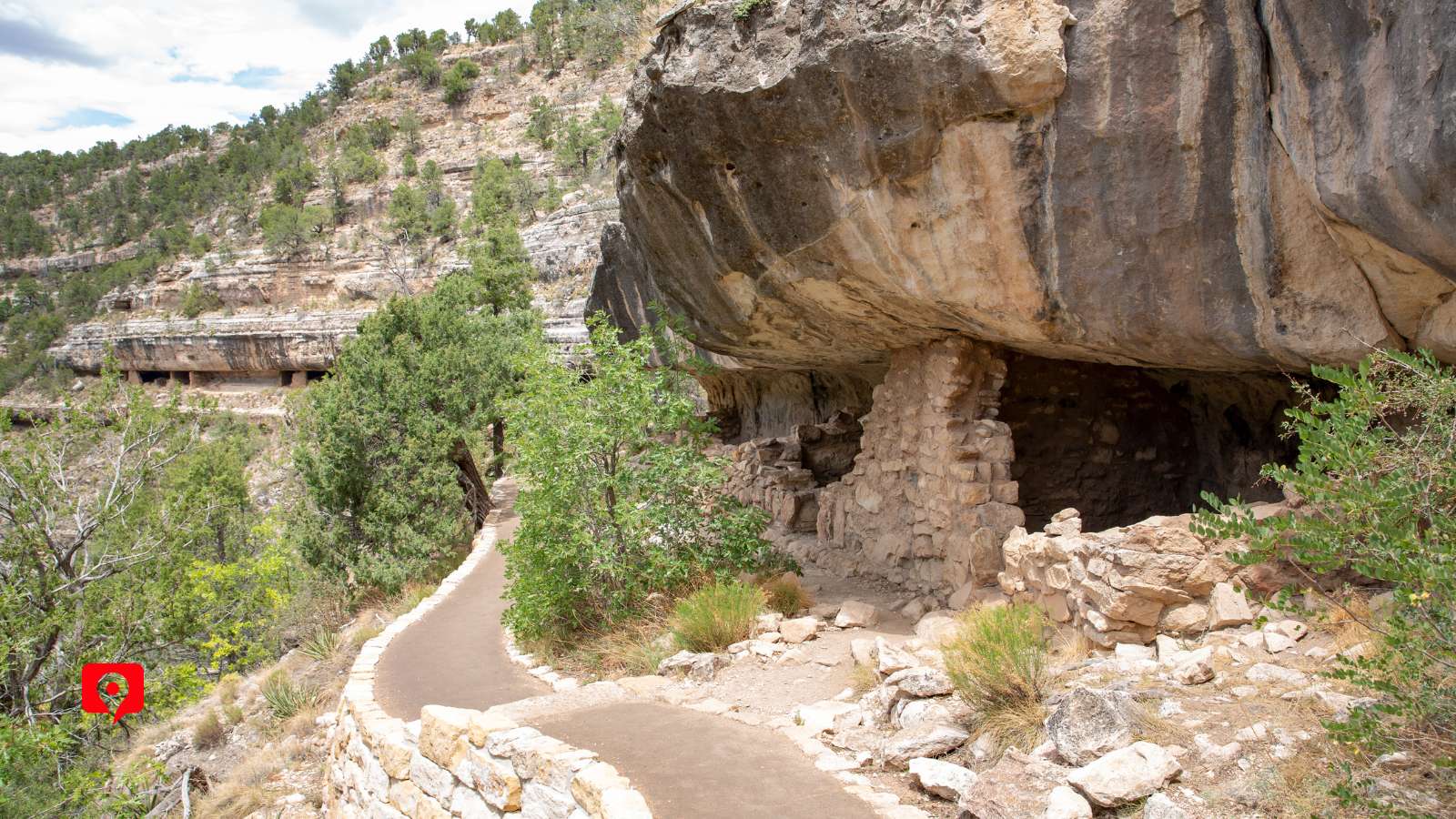
Another great Flagstaff hike is the Kachina Trail. This 10-mile out-and-back trail departs from the Snowbowl parking lot (that’s the local ski resort in winter). You’ll pass through ponderosa and aspen forest with opportunities to see plenty of wildlife as you navigate some 1500 feet of elevation change. Looking for more adventure? Summit Humphrey’s Peak, the highest mountain in Arizona at 12,633ft. Although it’s a similar length as the Kachina trail (about 10 miles), you’ll have 3300 feet of elevation gain to surmount as you trudge ever closer to the oxygen-thin summit.
Just outside of Winslow along the Little Colorado are a collection of archaeological sites that date back roughly 700 years. Four villages were once located here, where the ancestors of the Hopi lived before they migrated to their current mesa-top homes to the north (still visible from the park today on a clear day). A hike in Homolovi is not as spectacular as many other Arizona trails, but there’s nothing quite like the silence of walking through the desert to see ancient dwellings.
Want a place to get your trail runners on the ground in Kingman? Look no further. This 7-mile loop wends its way through the Mojave Desert, passing striking volcanic rock formations and plenty of cacti and ocotillo in the foothills west of town.
Not so long ago—about 1000 years, give or take—the local volcanic hotspot erupted roughly 20 miles northeast of Flagstaff, leaving behind lava flows, black cinder cones, and a layer of ash that covered 800 sq miles. Check out the unique geological features on the A’a and Lava Flow trails near the 1,000-foot-high Sunset Crater. They’re ¼ of a mile and 1 mile respectively. For more of a workout, clamber up the side of Lenox Crater (1.6 miles) to peer out at the volcanic landscape that surrounds you.
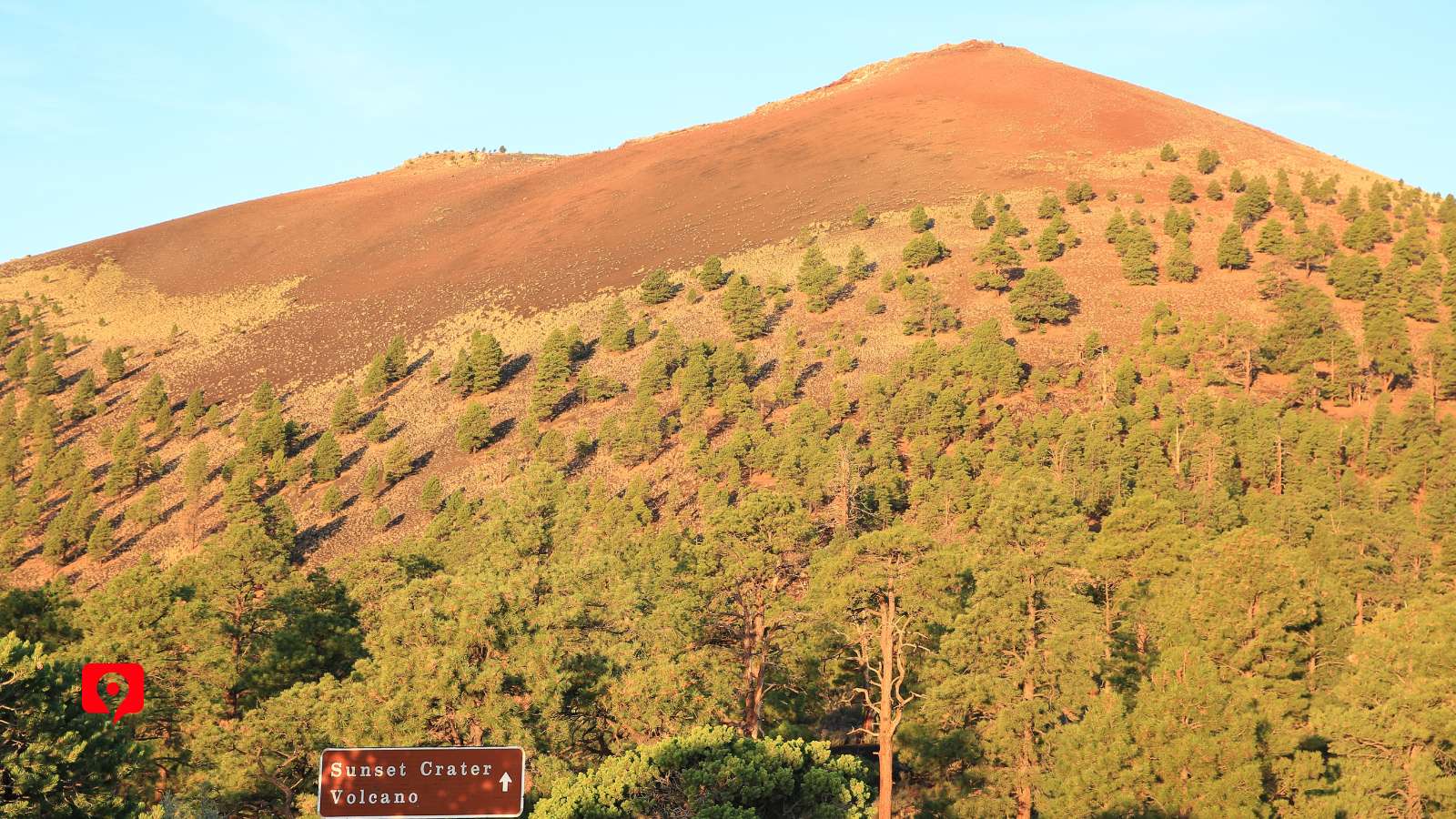
Show of hands: who’s seen a meteor crater before? If you haven’t, this is one of the best places to get up close and personal with a visitor from deep space: the site is one of the best preserved impact crater in the United States. About 50,000 years ago, a giant meteor smacked into the Earth outside Winslow at a speed of 11 miles per second. That impact created a giant crater in the earth’s crust, which has a circumference of three miles and is 700 feet deep. Bonus: in addition to the exhibits, film, and guided tours, you’ll also get to learn about the Apollo astronauts who trained here for their moon missions.
Part zoo, part wildlife safari, Bearizona in Williams allows you to do all your wildlife spotting in one place. Expect to see bears, elk, big horn sheep, bison and more as you drive through the park. At Fort Bearizona, you might just see some bear cubs scramble up a ponderosa—an unbeatable sight. Nearby is the Canyon Coaster Adventure Park, for kids who need a bit more thrills.
Ready for some Wild West humor? Don’t miss the bank-robbing gunslingers that draw their six shooters several times a day on Oatman’s main drag. The ever-present wandering burros (unscripted) add a bit of comedic authenticity to the show. There are usually four performances per day by two different groups; showtimes may vary according to the heat.
All aboard! This century-old railway was once the primary way to reach the Grand Canyon, replacing the far more uncomfortable stagecoach line from Flagstaff. If you’re doing a day trip to the Grand Canyon, consider leaving the car in Williams and taking the train instead—this tourist line has a daily departure around 9:30, arriving at the Grand Canyon depot just before lunchtime. You then have three and a half hours to explore the Grand Canyon before the train returns you to Williams before 6pm. Along the way, the Cataract Canyon Gang will try to board the train and rob the passengers of their valuables. You’ve been warned.
Once upon a time, Pluto was a full-fledged planet in our solar system, before it was demoted to “dwarf planet” on August 24, 2006. And believe it or not, Pluto was discovered right off Route 66 in Flagstaff at the Lowell Observatory in 1930. Today, the Lowell delights young and old astronomers alike with a variety of activities, ranging from evening stargazing to science exhibits and planetarium shows.
Sometimes, the best sunsets are the ones you catch simply by being at the right place at the right time—and on Route 66, you should expect to have plenty of those moments. But there’s no arguing that a spectacular natural landscape does even more to accentuate all those pastels hues that light up the sky. For the most spectacular shows, consider making a detour: both the Grand Canyon (north of Williams) and Sedona (south of Flagstaff) are off the charts for sunrises and sunsets.
Not to be outdone by the cars and trucks, bikers also have their week in the sun. This leather and chrome rally takes in all eight states in one week, but HQ is in Arizona at the off-the-grid Saddle Sore Ranch, near Cool Springs at the base of the Oatman Highway. It’s held annually in late April.
Even if you’re not a rail fan, it’s impossible not to notice all the freight trains chugging their way through the desert. After all, Route 66 in Arizona was built alongside the Atchison, Topeka and Santa Fe Railway tracks. Serious rail buffs will want to check out the opportunities in Winslow (La Posada is also an Amtrak stop) and Kingman in particular. And don’t miss Kingman’s Railroad Museum in the historic train depot.
Pull on your best pair of cowboy boots, a big old rhinestone belt buckle and a Stetson and get ready to electric slide the night away in Flagstaff. The giant log cabin Museum Club is the place to be, with free line dancing lessons on Tuesdays and Thursdays.
From Model Ts to Depression-era jalopies to Studebakers to Lightning McQueen, cars have always been the lifeblood of Route 66. The Route 66 Fun Run is the most famous of the classic car gatherings, with participants traveling the 140 miles between Seligman and Topock in over 800 vintage automobiles over a long weekend. It’s held in early May. The I Heart 66 Fest in Kingman has a classic car show for two days in October. Flagstaff also hosts a Mother Road Classic car show in mid-August every year. Williams, meanwhile, holds their car show in early June.
Extra Layers: Temperatures—and elevations—can vary considerably. It’s best to prepare for extremes (windier, drier, hotter, and colder than expected), so dressing in layers is the key to staying comfortable. A fleece and a lightweight jacket should do the trick.
Sun Protection: This essential includes a broad-brimmed hat, sunblock, and sunglasses. Zinc oxide lip balm will help combat cracked, sunburned lips. Applying thick moisturizing lotion with Shea butter or similar to nourish your skin should be part of your evening and morning routines.
Footwear: Grippy soles are best. A good pair of trail runners or lightweight hiking boots are an excellent choice for exploring most trails. Don’t make the mistake of wearing flip-flops or open-toed sandals, however; there are plenty of prickly plants and animals around, so keep those feet protected.
Water Bottles: Always bring extra water, and make sure you drink it! No matter what time of year you visit, dehydration is always a risk—even if you’re not doing much physical activity. In summer, it’s recommended that you drink up to a gallon a day.
Hiking Poles: Light-weight hiking poles are like having a third leg. They help maintain balance and can get you into a rhythm while walking.
Headlamp: You never know when a hike is going to take longer than planned—we always throw a lightweight headlamp in our daypack just in case.
Portable Phone Charger and Cable: If you’re taking pictures with your phone, running out of batteries may result in missed opportunities.
Daypack: A comfortable pack makes all the difference. In addition to carrying an extra layer, water, and headlamp, it’s a good idea to throw a few snacks in there as well.
First Aid Kit: Ibuprofen, different sized band-aids, antiseptic ointment, tweezers or knife (for removing cactus spines), medical adhesive tape, emergency whistle.
Please fill out this form and let us know
17 Mile Drive Acadia Alberta Arches ARIZONA AUSTRALIA Badlands Banff Kamploos Big Bend National Park Big Island Big Sky Drive Big Sur Black Canyon Black Hills Blue Lagoon Bryce Canyon CALIFORNIA CANADA Canadian Rockies Canyonlands Capitol Reef Catskills COLORADO Crater Lake Cuyahoga Valley Death Valley Delicate Arch Everglades FLORIDA Florida Keys Glacier Grand Canyon Grand Prismatic Grand Teton Haleakala HAWAII Hidden Valley Hikes Honolulu Iceland Iceland Golden Circle Itineraries Joshua Tree Kauai Lake Tahoe Lassen Volcanic Lodging Louisiana MAINE Maui MICHIGAN Montana Monument Valley Mount Lemmon Mount Rainier Mount Rushmore National Park NEVADA New Mexico New River Gorge NEW YORK NORTH CAROLINA North Cascades North Dakota Oahu Ohio Old Faithful Ontario OREGON Point Reyes Redwood Reykjanes Peninsula Rocky Mountain Route 66 Saguaro Santa Fe Sedona Smokies Snæfellsnes Peninsula Sonoma And Napa Valley SOUTH DAKOTA Tech Tips TENNESSEE Texas Theodore Roosevelt Travel Tips Trip Planners USA UTAH Videos Waikiki WASHINGTON West Thumb West Virginia White Sands Wildlife WYOMING Yellowstone Yosemite Zion
